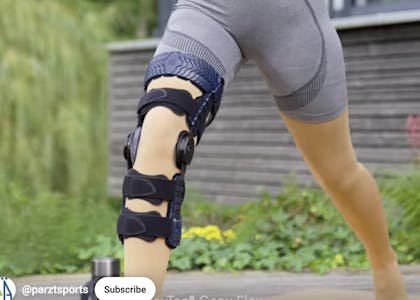
Bauerfeind braces and supports are often used in conjunction with physiotherapy to support rehabilitation, manage pain, and promote active recovery for various musculoskeletal conditions and injuries.
Here’s a breakdown of their role in physiotherapy:
1. Pain and Swelling Management
- Compression and Massage : Many Bauerfeind products use a medical-grade compression knit fabric that, when worn and moved in, provides an intermittent massage effect. This is designed to boost circulation, which helps to reduce swelling (edema) and pain in and around the affected joint.
- Targeted Relief : Viscoelastic pads and specialized strap systems are incorporated into braces like the GenuTrain (for knees) or EpiTrain (for elbows) to provide targeted pressure relief and massage to sensitive areas, further alleviating discomfort during therapeutic exercises.
2. Stabilization and Support
- Joint Stability: The braces provide mechanical support and stability to injured or unstable joints (e.g., following a ligament tear, or due to conditions like osteoarthritis). This secure feeling can give patients the confidence to participate in physiotherapy and daily activities.
- Proprioception Enhancement: The compression knit material stimulates the body’s proprioceptors (sensory receptors that provide awareness of joint position and movement). This improved feedback to the brain can lead to better muscle control, coordination, and joint mechanics, which is a core goal of physiotherapy.
3. Active Recovery and Function
- Facilitating Movement: Unlike rigid casts, many Bauerfeind supports are designed to be flexible and breathable, allowing for guided and supported movement. This helps patients stay active and engage in exercises—often a critical part of a physiotherapy protocol—to restore function and motion.
- Muscle Activation: The compression and gentle stimulation can help activate the muscles surrounding the joint, encouraging them to provide better support and reducing muscle fatigue.
- Injury-Specific Protocols: Certain Bauerfeind products, such as the SecuTec series, are integral to specific conservative treatment methods (like the Cross Brace Protocol for ACL ruptures) where the brace is used to precisely control the knee’s range of motion during a structured healing phase that is closely managed by a clinician and physical therapist.
Common Conditions Where They Are Used:
- Knee:
- Osteoarthritis
- Ligament injuries (ACL, PCL, MCL, LCL)
- Meniscus injuries
- Patellofemoral pain
- Ankle:
- Chronic instability,
- Ligament tears
- Post-operative rehabilitation
- Achilles tendon issues
- Elbow:
- Tennis elbow
- Golfer’s elbow
- Arthritis
- Back:
- Lower back pain
- SI joint dysfunction
- Stabilization following injury
A physicotherapist will typically assess a patient’s condition and integrate the use of a brace or support into a personalized treatment plan, ensuring it complements the manual therapy, exercise, and education components.